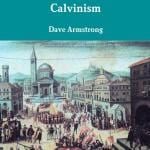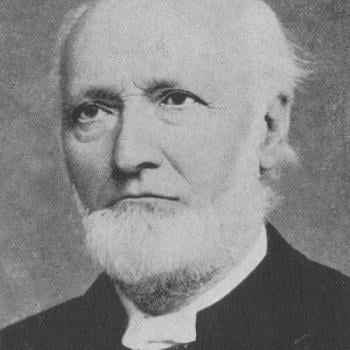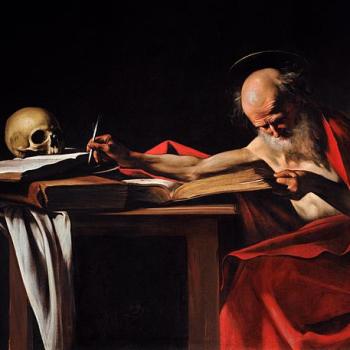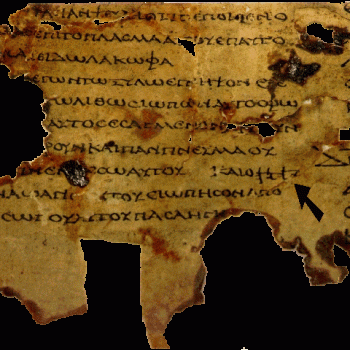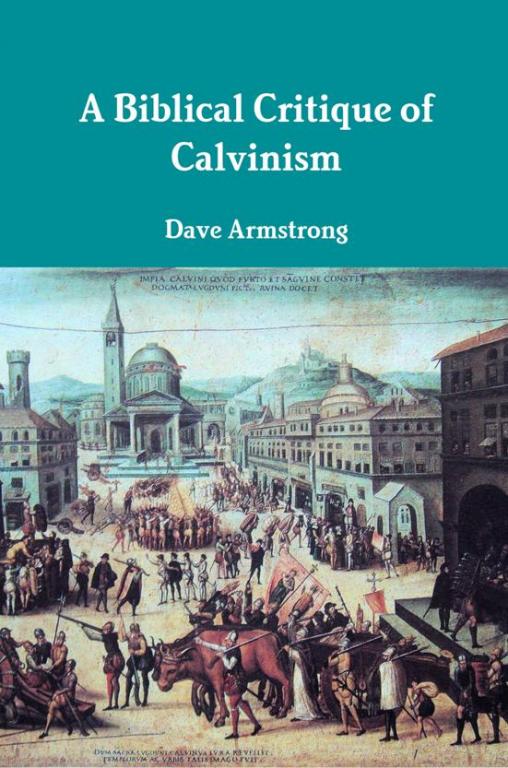
[excerpt from my book, A Biblical Critique of Calvinism (Oct. 2012, 178p), pp. 59-72. Follow the link for content and purchase information]
***
I’ll be using, the (public domain) translation of Institutes of the Christian Religion by Henry Beveridge, produced for the Calvin Translation Society in 1845, from the 1559 edition in Latin; reprinted by William B. Eerdmans Publishing Company (Grand Rapids, Michigan), 1995, and available online at the wonderful Christian Classics Ethereal Library site. My own Bible passages are from RSV. Calvin’s words will be in blue.
***
First, it is said in the books of Moses (Deut. 4:15), “Take ye therefore good heed unto yourselves; for ye saw no manner of similitude in the day that the Lord spake unto you in Horeb, out of the midst of the fire, lest ye corrupt yourselves, and make you a graven image, the similitude of any figure,” &c. We see how plainly God declares against all figures, to make us aware that all longing after such visible shapes is rebellion against him. (I, 11:2)
“All figures”? This is untrue, since God commanded the fashioning of the ark, the temple, and altars: all of which were used in terms of God being specially present in each: through the physical object in some way.
Of the prophets, it will be sufficient to mention Isaiah, who is the most copious on this subjects (Isaiah 40:18; 41:7, 29; 45:9; 46:5), in order to show how the majesty of God is defiled by an absurd and indecorous fiction, when he who is incorporeal is assimilated to corporeal matter; he who is invisible to a visible image; he who is a spirit to an inanimate object; and he who fills all space to a bit of paltry wood, or stone, or gold. (I, 11:2)
The same God commanded the Jews to build an ark of wood and gold, where He would meet them, and the same prophet Isaiah states: “O LORD of hosts, God of Israel, who art enthroned above the cherubim” (Is 37:16). This refers to the ark of the covenant, as elaborated upon in many other passages (listed above).
It’s not a matter of foolishly thinking that God is a mere piece of wood or gold (Catholics are completely at one with Calvin in decrying that), but rather, of using objects as aids to devotion to God (an eminently biblical practice). This is what Calvin and Calvinists also don’t grasp regarding statues as devotional aids to ask for the intercession of saints, and to venerate or honor (not adore!) them.
Paul, too, reasons in the same way, “Forasmuch, then, as we are the offspring of God, we ought not to think that the Godhead is like unto gold, or silver, or stone, graven by art and man’s device,” (Acts 17:29). Hence it is manifest, that whatever statues are set up or pictures painted to represent God, are utterly displeasing to him, as a kind of insults to his majesty. (I, 11:2)
This is a baseless argument, since God became man (it’s called the incarnation). We have seen God in the flesh. Jesus Christ “is the image [Gk., eikon] of the invisible God” (Col 1:15). If men have seen our Lord, touched Him, had His physical appearance in their memory, what possible objection can be made to a painting or statue of Him?
Why is the latter worse than the former? Everyone knows that Jesus wasn’t made of gold or wood. He was a man. They know that the image of a statue or painting represents Him and is not identical to Him, just as they know that such works of art in general represent any number of things. Calvin virtually refutes himself in this vein, by writing:
God sometimes appeared in the form of a man, but this was in anticipation of the future revelation in Christ, and, therefore, did not give the Jews the least pretext for setting up a symbol of Deity under the human form. (I, 11:3)
This is the whole point! We’re now in the new covenant period. Jesus Christ has already come; God has become man. What was anticipated has come to pass. And it seems clear that in a post-incarnational world, images are perfectly acceptable, rightly understood. People (with rare exceptions) understand what they are. They are devotional aids, not idols.
Moreover, all men of sound Judgment acknowledge that the Cherubim in question belonged to the old tutelage of the law. It is absurd, therefore, to bring them forward as an example for our age. For that period of puerility, if I may so express it, to which such rudiments were adapted, has passed away. (I, 11:3)
Calvin refers specifically to the cherubim on the ark of the covenant. But that was not the only place where carved cherubim appeared, with the express sanction of God. In the first magnificent structure built by Solomon, two giant cherubim (ten cubits, or about fifteen feet high) of wood, covered with gold, stood in the inner sanctuary (1 Ki 6:23-28; 8:6-7; 2 Chr 3:10-13; 5:7-8). Each of their wings was 7-8 feet in length.
Images of cherubim were also carved on the cedar planks of the inner walls of the temple, and on the doors made of olive-wood (1 Ki 6:29, 35; 2 Chr 3:7), as well as on the portable lavers, along with lions and oxen (1 Ki 7:29-36), and woven in the veil of the Holy of Holies (2 Chr 3:14), following the pattern of cherubim in the inner curtain of the tabernacle and the veil (Ex 26:1, 31; 36:8, 35).
In the second temple, according to Ezekiel, the inner walls were carved with both palm trees and cherubim, with faces of a lion and a man (Ezek 41:18-25).
Likewise, the walls of Herod’s (third) temple were painted with figures of cherubim, according to the Talmud (Yoma’ 54a).
That’s an awful lot of images, in the very place where God was especially present, and worshiped most fervently, commanded by the same God, Who allegedly didn’t want any images of any sort connected with worship (if not during the entire old covenant, at least during the new). Such is the manifest absurdity of Calvin’s unbiblical iconoclasm.
With some subtlety, however, Calvin (seemingly with presumptuous reluctance) accepts the older image-laden worship as legitimate under “the old tutelage of the law”: a “period of puerility” that has “passed away,” while holding that it is “absurd” in “our age.” This is a tendentious argument – rather typical in Calvinism and many strains of Protestantism –, that assumes far too great of a break between the old and new covenants.
In fact, temple worship was quite consistent with the new covenant. Jesus and the disciples certainly participated in it. If Calvin wishes to argue that this was a transitional period, then surely in the time of St. Peter and St. Paul, after Pentecost, it is the new covenant, or Church age.
Acts 3:1 tells us that Peter and John worshiped in the temple, during the ninth hour, which was 3 PM: the time when sacrifice was offered (Ex 29.39; Lev. 6.20; cf. Josephus, Ant. xiv.4.3). Acts 2:46 described the early Christians as “day by day, attending the temple together.”
St. Paul alludes to his own presence and worship in the temple (Acts 24:12), and is described as continuing to participate in its rituals (Acts 21:26: “Then Paul took the men, and the next day he purified himself with them and went into the temple, to give notice when the days of purification would be fulfilled and the offering presented for every one of them” — cf. 25:8: “Neither against the law of the Jews, nor against the temple, nor against Caesar have I offended at all”).
In Acts 22:7 he refers to his practice of “praying in the temple,” and in Acts 24:18 as having been “purified in the temple” (see also 24:17: “I came to bring to my nation alms and offerings”).
This was only interrupted by the Romans’ destruction of Herod’s temple in 70 A.D. Otherwise, in principle, Christians (particularly ethnically Jewish Christians) could have continued to participate in temple worship: complete with all the images involved. Nothing in these practices was intrinsically hostile to Christian teaching.
Therefore, Calvin’s contention is demolished. This was Herod’s temple, which had cherubim painted on its walls. Jesus, Peter, and Paul all worshiped there. It had cherubim on its walls, meaning that the “period” of “such rudiments” had not “passed away,” as Calvin would have us believe.
If images in a temple were good enough for Jesus and Paul, then surely they are permissible for us. Yet Calvin and Calvinists historically have opposed not only images on walls (i.e., stained glass), but even organs, statues of Christ, crucifixes; even bare crosses: all as supposed “idols,” in their extreme iconoclasm that cannot be sanctioned from Scripture for a second, as we have demonstrated.
Even in the end times, the ark of the covenant and the temple continue to appear in heaven:
Revelation 11:19 Then God’s temple in heaven was opened, and the ark of his covenant was seen within his temple . . .
Further references to a “temple” in heaven occur in Revelation 3:12; 7:15; 11:1-2; 14:15, 17; 15:5-6, 8; 16:1, 17.
It is, moreover, to be observed, that by the mode of expression which is employed, every form of superstition is denounced. Being works of men, they have no authority from God (Is 2:8; 31:7; Hos 14:3; Mic 5:13); and, therefore, it must be regarded as a fixed principle, that all modes of worship devised by man are detestable. (I, 11:4)
Here Calvin handily refutes his own man-made tradition of iconoclasm (a heresy from the eighth century – long since condemned by the historic Church — that he regurgitated). Now that we have seen that images of many kinds were associated with worship (including in the new covenant, by Jesus’ and Paul’s own examples), we know that iconoclasm, or the antipathy to all images in worship and piety is merely a mode of worship “devised by man” (since it runs contrary to biblical revelation).
Therefore, it must be rejected, and Calvin’s entire argument regarding “graven images” is self-refuting. Whatever is true in it (God is not a man-made idol of wood) was never disagreed with by the Catholic Church at any time.
But Calvin’s and Calvinist iconoclasm is mostly a fallacious, hyper-legalistic, far too broad misapplication of the prohibition of graven images in the Ten Commandments, leading to almost ubiquitous ludicrous charges of “idolatry” against Catholics and Orthodox for nearly 500 years now, and to other errors such as the antipathy to efficacious sacraments as conveyors of grace, sacramentals, and the veneration of saints. Calvin’s extreme view is particularly seen in the following passage:
And it is to be observed, that the thing forbidden is likeness, whether sculptured or otherwise. This disposes of the frivolous precaution taken by the Greek Church. They think they do admirably, because they have no sculptured shape of Deity, while none go greater lengths in the licentious use of pictures. The Lord, however, not only forbids any image of himself to be erected by a statuary, but to be formed by any artist whatever, because every such image is sinful and insulting to his majesty. (I, 11:4)
I would ask, then: why did God become man at all, if any sense of image in relation to God, is so utterly forbidden? If the idea is to push a completely spiritual, invisible, non-visual God (as indeed the Father is), why appear in human flesh at all? Thus, this sort of absurd iconoclasm is ultimately anti-incarnational. It leads oftentimes in the minds of those who hold it, to an antipathy to matter itself, which is reflective or reminiscent of ancient Docetism and even Gnosticism in some respects.
In this view, we can picture God as a man (we could even have met Him in person, if we had lived during the times that God the Son, Jesus, walked the earth), but all images of Him whatsoever are forbidden. No such prohibition occurs in Scripture. Not all images are graven images (i.e., idols). It is the foolish equation of the two (as if they are always identical) that is Calvin’s fundamental error in this regard. He can’t seem to comprehend any image that is not an idol. But this is clearly a ludicrous viewpoint, and one unsustainable from Holy Scripture.
Therefore, whether it be God or a creature that is imaged, the moment you fall prostrate before it in veneration, you are so far fascinated by superstition. (I, 11:9)
For why do men prostrate themselves before images? (I, 11:10)
It’s curious, then, that as great a figure as Joshua didn’t understand this. He prostrated himself before the ark of the covenant, which had the two cherubim (images of creatures) on top:
Joshua 7:6-7 Then Joshua rent his clothes, and fell to the earth upon his face before the ark of the LORD until the evening, he and the elders of Israel; and they put dust upon their heads. [7] And Joshua said, “Alas, O Lord GOD, why hast thou brought this people over the Jordan at all, to give us into the hands of the Amorites, to destroy us? Would that we had been content to dwell beyond the Jordan!”
In the larger passage, no hint occurs that Joshua had done anything wrong whatsoever, let alone descended into “superstition.” The Bible also describes worshipers as bowing before the temple (prostration), thus engaging in mass superstition, according to Calvin (while the Bible never condemns it). This includes images as well, since the temple was covered in images of cherubim, as noted previously:
2 Chronicles 7:3 When all the children of Israel saw the fire come down and the glory of the LORD upon the temple, they bowed down with their faces to the earth on the pavement, and worshiped and gave thanks to the LORD, saying, “For he is good, for his steadfast love endures for ever.”
Psalm 138:2 I bow down toward thy holy temple and give thanks to thy name for thy steadfast love and thy faithfulness . . .
Judith 4:11 And all the men and women of Israel, and their children, living at Jerusalem, prostrated themselves before the temple and put ashes on their heads and spread out their sackcloth before the Lord.
Having engaged again and again in extreme and illogical thought regarding images, Calvin at length sees fit to inconsistently temper his expressed legalism:
I am not, however, so superstitious as to think that all visible representations of every kind are unlawful. But as sculpture and painting are gifts of God, what I insist for is, that both shall be used purely and lawfully,—that gifts which the Lord has bestowed upon us, for his glory and our good, shall not be preposterously abused, nay, shall not be perverted to our destruction. . . . The only things, therefore, which ought to be painted or sculptured, are things which can be presented to the eye; the majesty of God, which is far beyond the reach of any eye, must not be dishonored by unbecoming representations. Visible representations are of two classes—viz. historical, which give a representation of events, and pictorial, which merely exhibit bodily shapes and figures. The former are of some use for instruction or admonition. The latter, so far as I can see, are only fitted for amusement. And yet it is certain, that the latter are almost the only kind which have hitherto been exhibited in churches. . . . I only say, that though they were otherwise faultless, they could not be of any utility in teaching. (I, 11:12)
*
This is quite curious, since Calvin seems unaware that he has once again defeated his own earlier arguments. If images of God are so horrendous and impermissible, yet paintings that “give a representation of events . . . are of some use for instruction,” then on what grounds can he forbid a painting of the crucifixion? He would have to hold that Jesus (the “image of the invisible God”) cannot possibly ever be portrayed in painting or sculpture, since this is (so he mistakenly thinks) intrinsically idolatrous.
But this is at cross-purposes to his concession that events can be properly portrayed. Why then, cannot the most important event in history be portrayed, for our edification? It makes no sense. Once again, at bottom, or as a logical reduction, this sort of thought is hostile to the very notion of God becoming man (hence, visible and historical). It’s anti-incarnational.
Men can look upon Jesus on the cross in real life and worship Him, but they can’t possibly (so Calvin would have us believe) look at a crucifix or painting of the crucifixion and worship Him through the visual aid supplied.
[L]et us here consider, whether it is expedient that churches should contain representations of any kind, whether of events or human forms. First, then, if we attach any weight to the authority of the ancient Church, let us remember, that for five hundred years, during which religion was in a more prosperous condition, and a purer doctrine flourished, Christian churches were completely free from visible representations . . . Hence their first admission as an ornament to churches took place after the purity of the ministry had somewhat degenerated. . . . from the fearful infatuation under which the world has hitherto laboured, almost to the entire destruction of piety, we know too well from experience that the moment images appear in churches, idolatry has as it were raised its banner; because the folly of manhood cannot moderate itself, but forthwith falls away to superstitious worship. Even were the danger less imminent, still, when I consider the proper end for which churches are erected, it appears to me more unbecoming their sacredness than I well can tell, to admit any other images than those living symbols which the Lord has consecrated by his own word: I mean Baptism and the Lord’s Supper, with the other ceremonies. By these our eyes ought to be more steadily fixed, and more vividly impressed, than to require the aid of any images which the wit of man may devise. (I, 11:13; italics added)
Digressing too deeply into historical matters isn’t appropriate in a book about biblical theology, but it can hardly be passed over, that this is massively untrue, as a matter of historical record; it’s the exact opposite of the truth. The theology of images developed in the Church, just as every other doctrine did. But it did not take anywhere near “five hundred years.” Nor were images per se at all slow to occur in Christian circles.
The Catholic Encyclopedia (New York: Robert Appleton Company, 1910), noted in its article, “Veneration of Images” (written by Adrian Fortescue):
That Christians from the very beginning adorned their catacombs with paintings of Christ, of the saints, of scenes from the Bible and allegorical groups is too obvious and too well known for it to be necessary to insist upon the fact. The catacombs are the cradle of all Christian art. Since their discovery in the sixteenth century — on 31 May, 1578, an accident revealed part of the catacomb in the Via Salaria — and the investigation of their contents that has gone on steadily ever since, we are able to reconstruct an exact idea of the paintings that adorned them. That the first Christians had any sort of prejudice against images, pictures, or statues is a myth (defended amongst others by Erasmus) that has been abundantly dispelled by all students of Christian archaeology. The idea that they must have feared the danger of idolatry among their new converts is disproved in the simplest way by the pictures even statues, that remain from the first centuries. . . . They accepted the art of their time and used it, as well as a poor and persecuted community could, to express their religious ideas. Roman pagan cemeteries and Jewish catacombs already showed the way; Christians followed these examples with natural modifications. From the second half of the first century to the time of Constantine they buried their dead and celebrated their rites in these underground chambers. . . . The Christian sarcophagi were ornamented with indifferent or symbolic designs — palms, peacocks, vines, with the chi-rho monogram (long before Constantine), with bas-reliefs of Christ as the Good Shepherd, or seated between figures of saints, and sometimes, as in the famous one of Julius Bassus with elaborate scenes from the New Testament. And the catacombs were covered with paintings.
. . . Certain scenes from the Old Testament that have an evident application to His life and Church recur constantly: Daniel in the lions’ den, Noah and his ark, Samson carrying away the gates Jonas, Moses striking the rock. Scenes from the New Testament are very common too, the Nativity and arrival of the Wise Men, our Lord’s baptism, the miracle of the loaves and fishes, the marriage feast at Cana, Lazarus, and Christ teaching the Apostles. There are also purely typical figures, the woman praying with uplifted hands representing the Church, harts drinking from a fountain that springs from a chi-rho monogram, and sheep. And there are especially pictures of Christ as the Good Shepherd, as lawgiver, as a child in His mother’s arms, of His head alone in a circle, of our Lady alone, of St. Peter and St. Paul — pictures that are not scenes of historic events, but, like the statues in our modern churches, just memorials of Christ and His saints. In the catacombs there is little that can be described as sculpture; there are few statues for a very simple reason. Statues are much more difficult to make, and cost much more than wall-paintings. But there was no principle against them. Eusebius describes very ancient statues at Caesarea Philippi representing Christ and the woman He healed there (Church History VII.18; Matthew 9:20-2). The earliest sarcophagi had bas-reliefs. As soon as the Church came out of the catacombs, became richer, had no fear of persecution, the same people who had painted their caves began to make statues of the same subjects. The famous statue of the Good Shepherd in the Lateran Museum was made as early as the beginning of the third century, the statues of Hippolytus and of St. Peter date from the end of the same century. The principle was quite simple. The first Christians were accustomed to see statues of emperors, of pagan gods and heroes, as well as pagan wall-paintings. So they made paintings of their religion, and, as soon as they could afford them, statues of their Lord and of their heroes, without the remotest fear or suspicion of idolatry.
The idea that the Church of the first centuries was in any way prejudiced against pictures and statues is the most impossible fiction. After Constantine (306-37) there was of course an enormous development of every kind. Instead of burrowing catacombs Christians began to build splendid basilicas. They adorned them with costly mosaics, carving, and statues. But there was no new principle. The mosaics represented more artistically and richly the motives that had been painted on the walls of the old caves, the larger statues continue the tradition begun by carved sarcophagi and little lead and glass ornaments. From that time to the Iconoclast Persecution holy images are in possession all over the Christian world. St. Ambrose (d. 397) describes in a letter how St. Paul appeared to him one night, and he recognized him by the likeness to his pictures (Ep. ii, in P.L., XVII, 821). St. Augustine (d. 430) refers several times to pictures of our Lord and the saints in churches (e.g. “De cons. Evang.”, x in P.L., XXXIV, 1049; Reply to Faustus XXII.73); . . . St. Jerome (d. 420) also writes of pictures of the Apostles as well-known ornaments of churches (In Ionam, iv). St. Paulinus of Nola (d. 431) paid for mosaics representing Biblical scenes and saints in the churches of his city, and then wrote a poem describing them (P.L., LXI, 884). . . . In the East St. Basil (d. 379), preaching about St. Barlaam, calls upon painters to do the saint more honour by making pictures of him than he himself can do by words (“Or. in S. Barlaam”, in P.G., XXXI). St. Nilus in the fifth century blames a friend for wishing to decorate a church with profane ornaments, and exhorts him to replace these by scenes from Scripture (Epist. IV, 56). St. Cyril of Alexandria (d. 444) was so great a defender of icons that his opponents accused him of idolatry . . . St. Gregory the Great (d. 604) was always a great defender of holy pictures . . .
. . . Although representations of the Crucifixion do not occur till later, the cross, as the symbol of Christianity, dates from the very beginning. Justin Martyr (d. 165) describes it in a way that already implies its use as a symbol (Dialogue with Trypho 91). He says that the cross is providentially represented in every kind of natural object: the sails of a ship, a plough, tools, even the human body (Apol. I, 55). According to Tertullian (d. about 240), Christians were known as “worshippers of the cross” (Apol., xv). Both simple crosses and the chi-rho monogram are common ornaments of catacombs; combined with palm branches, lambs and other symbols they form an obvious symbol of Christ. After Constantine the cross, made splendid with gold and gems, was set up triumphantly as the standard of the conquering Faith. A late catacomb painting represents a cross richly jewelled and adorned with flowers.
. . . The conclusion then is that the principle of adorning chapels and churches with pictures dates from the very earliest Christian times . . .
If Calvin wants to dare make an appeal to ancient Church history in order to bolster his already radically unbiblical case against images in Christianity, he is clearly on very shaky ground. If he wants to argue that all this is, by nature, idolatry, then it appeared immediately in Christian history, and there was never any “pure” age (in his view) at all. Christians were almost universally rank idolaters (just as Calvin viewed the Catholics of his time, who followed these early Church practices). As so often, he must defend his novel doctrines in direct opposition to the early Church and the Bible.
***



